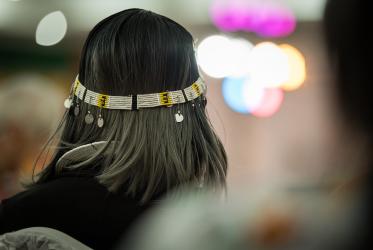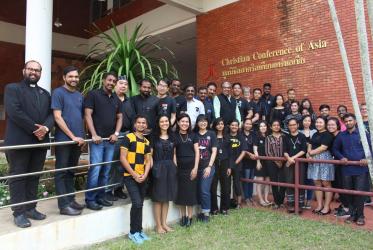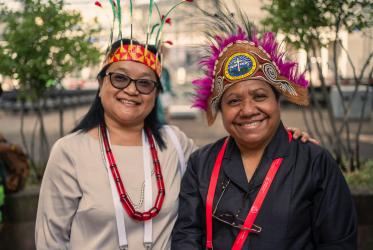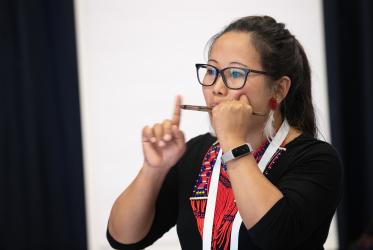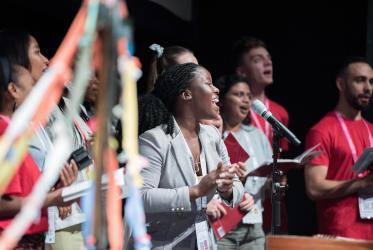By Maurice Malanes (*)
Stories of transformation
Feature series towards the WCC 9th Assembly
More articles and free photos in
They had literally groped in the dark for ages. But for the past three years, more than a thousand upland folk in a remote village in northern Philippines have felt blessed because they are finally seeing the light of fluorescent bulbs.
Before Episcopalian (Anglican) Bishop Joel Pachao inaugurated a 15-kilowatt micro-hydroelectric plant in the village of Lon-oy (some 250 kilometres north of Manila) in San Gabriel town in La Union Province in March 2002, local folk had to content themselves with kerosene lamps for lighting.
"It was really a pity to see them groping in the dark at night time," says Frank Taguba, an engineer of the non-governmental Sibol ng Agham at Teknolohiya (SIBAT or Wellspring of Science and Technology), who helped design and supervize the micro-hydro power plant's construction.
Accessible by a steeply rising road after three hours of tough driving from the centre of San Gabriel town, Lon-oy is one of 10,000 villages nationwide not covered by the state-run National Power Corporation's grid. Under the government's Philippine Energy Plan, Lon-oy is among the villages scheduled to be energized by 2010. But this is only on paper. And even so, year 2010 also meant quite a long wait for Lon-oy villagers.
So, on their own, the villagers - most of them Anglicans - and the Episcopal Diocese of North-Central Philippines' community-based development programme desk jointly conceived a micro-hydro power plant project. Aside from helping design and supervize the project, SIBAT convinced the Philippine government's energy department to provide the 1.5 million-peso (some 26,800 USD or 22,000 Euro) fund for the project.
As their counterpart contribution, the more than 130 families in the village took care of the project's labour. For three years, not only the men, but also women and teenage youths dug and cemented a more than a kilometre-long diversion canal from the Lon-oy River upstream. The canal leads to a penstock and power house downstream, where the force of water is converted into electricity by a generator.
Mainly designed for lighting only, the micro-hydro power facility has enabled each household to avail itself of a maximum of 80 watts. More luxurious appliances such as television sets, refrigerators and electric ovens are not allowed. Otherwise, the facility breaks down due to power overload.
But providing light alone has already worked wonders for the villagers. Instead of straining their eyes with kerosene lamps, school teachers can now work more comfortably under bright electric lights as they plan their lessons and check papers.
Broom-makers can now make brooms for sale until late in the evening. Sitting around a winnower with newly harvested legumes and beans to peel, members of a family also exchange stories and riddles and sing songs before they go to bed.
Early in the morning, members of an association of village women can start baking bread in their liquefied petroleum gas-fueled oven in their bakery. Before, they had to wait for daybreak before baking.
The women have also embarked on a food-processing project, which they can now attend to in the evening and in the early morning. They are processing ginger into tea, for example, something that they could not do before.
The micro-hydro facility has not only opened livelihood opportunities for the villagers. It has also opened opportunities for spiritual growth, says Johnny Golocan, an engineer and lay leader who coordinates the development programme of the Episcopal Diocese of North-Central Philippines.
"With the electricity, our parishioners in Lon-oy can do their Bible studies and fellowship and prayer meetings even in the evening," he says.
<span style="font-weight: bold; "» A spreading gospel brings life more abundant
The gospel of giving light through micro-hydro power has also spread farther north to the distant village of Buneg in Conner town in Apayao Province, some 550 kilometres north of Manila.
The more than 300 indigenous Mabaka folk (one of more than 80 ethno-linguistic and indigenous groups in the Philippines) of Buneg got in touch with the Catholic Church and the non-governmental SIBAT to help install a 7.5 kilowatt micro-hydro power facility. Like Lon-oy, Buneg is not a priority in the government-run National Power Corporation's grid.
During six years, the Mabaka patiently hauled construction materials - from cement, steel bars and pipes to the turbine and generator - because from the nearest road Buneg is accessible only by foot after a six- to seven-hour uphill climb. SIBAT provided the expertise and also channeled funds from the United Nations Development Programme.
Inaugurated in January 2003, the Buneg micro-hydro power facility has since been providing electric lighting to 36 families, and helping give more livelihood opportunities to the upland folk.
Before he calls it a day, Mabaka elder Andanan Agagen weaves rattan baskets in the evening, which he sells to lowland folk. The rattan baskets that he weaves helped send a daughter to college. "It was beyond my wildest dreams that I would see the light of an electric bulb in my lifetime," says the 70-something elder. "I can only thank the heavens and those who made this miracle possible."
Under bright fluorescent lamps, children can now study their lessons and read books while Rosalina Dangli, the community's lone public teacher, can plan her lessons for the next day.
In 2004, the Mabaka folk were able to access some funds for a hydraulic-powered rice mill, which has helped lighten the burden carried by women and children, who, by tradition, pound rice. "Freed from the back-breaking task of pounding rice, children have more time to study their lessons," says Dangli.
In other remote villages the government's energy programme cannot reach, similar community-based micro-hydro power projects are helping start a quiet industrial revolution. Blacksmith shops, rice mills, sugar-cane pressers, even a vulcanizing shop, are now allowing families to improve their livelihoods.
Asked about the role of micro-hydro projects in the overall scheme of the Episcopal Church of the Philippines' vision and mission, Golocan says: "In a small but concrete way, these simple facilities can help improve and transform the lives of our parishioners. We are happy to see how, for many poor families, they help usher in the abundant life that Christ promised." [1,009 words]
(*) Maurice Malanes is a freelance journalist from the Philippines. Currently a correspondent for Ecumenical News International (ENI), he also writes for the Manila-based Philippine Daily Inquirer, and the Bangkok-based Union of Catholic Asian News (UCAN).
[Sidebar text]
9th WCC Assembly: Praying for a transformed world
The 9th assembly of the World Council of Churches (WCC) will be held in Porto Alegre, Brazil, from 14-23 February 2006. Its theme is a prayer: "God, in your grace, transform the world".
The first WCC assembly of the 21st century, it will gather up to 3,000 church leaders and ecumenical representatives from nearly every Christian tradition around the world. As such, it will be one of the broadest global gatherings of its kind.
WCC assemblies are often turning points in the life of the World Council, and this one is expected to leave its mark on ecumenical history. Deliberations will focus on issues such as the future of the ecumenical movement, the churches' commitment to economic justice as well as their witness to overcoming violence, and the challenges faced in the midst of religious plurality.
In Porto Alegre, members of the ecumenical family will be able to gather around the assembly at a Mutirão, a Portuguese word that means coming together for a common purpose. Made up of workshops, exhibitions and cultural celebrations, this part of the assembly programme will offer opportunities for members of the wider ecumenical movement to gather, reflect and celebrate together.
This is the first WCC assembly to be held in Latin America, and it is being hosted by the National Council of Christian Churches in Brazil (CONIC) on behalf of churches throughout the region. Pre-assembly events for youth and for women will be held from 11-13 February.
Assembly website: www.wcc-assembly.info
[246 words]
- - - - -
Stories of transformation - feature series towards the WCC 9th Assembly
Information for editors and journalists
Stories of transformation is a feature series intended to help Christian publications to raise awareness about the WCC 9th Assembly among their readers.
Each month, articles will focus on various facets of the life of the WCC fellowship of churches in the light of the assembly theme "God, in your grace, transform the world", as well as on different aspects of the assembly itself.
Stories may be shortened (please acknowledge). Feedback and notice of any use of our features will be much appreciated. Thank you.
- - - - -
